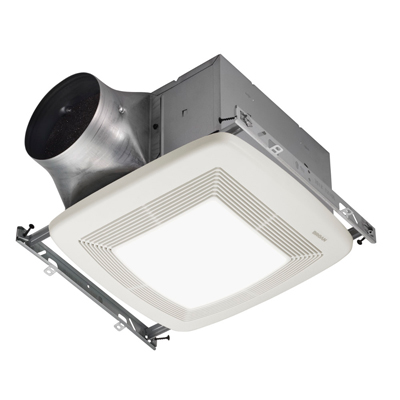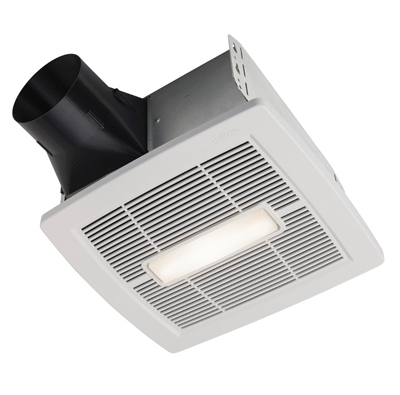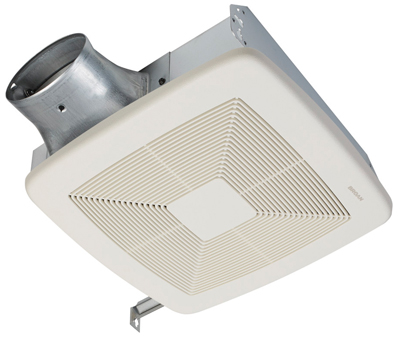What are the codes and how can you meet them?
By: Patrick Nielsen, Global Technical Products Manager, BroanThe International Residential Code (IRC) is a comprehensive, stand-alone residential code that creates minimum regulations for one- and two-family dwellings of three stories or less. It brings together all building, plumbing, mechanical, fuel gas, energy and electrical provisions for one- and two-family residences.
The 2012 and 2015 versions of the International Residential Codes require minimum spot/local airflow rates and whole house ventilation. The spot ventilation requirement, for instance, requires 50 cfm of actual delivered airflow in bathrooms. Based on typical ducting installations being less airflow-friendly than where bath fans are rated, typically a fan rated at 80 cfm is needed to ensure the inspector will actually measure at least 50 cfm.
Today’s tightly built homes are great for lower utility bills but can also cause problems with indoor air quality. These codes require a minimum amount of essentially continuous ventilation airflow based on the size of a home. This airflow can be met either through exhaust (pulling stale air out), supply (pushing fresh air in) or balanced (a combination of both) ventilation.
The 2018 version has a key change: the requirement that all exhaust equipment serving single dwelling units such as bath ventilation fans and range hoods need to be listed and labeled as providing the minimum required airflow in accordance with ANSI testing standards. This essentially means that they need to be certified by a certification body – usually the Home Ventilating Institute (HVI) in the case of residential ventilation. Electrical distributors should make sure the exhaust ventilation products they carry are certified (a certified products directory can be found at hvi.org).
The state of Ohio will adopt the 2018 IRC this year. There may also be municipalities across the country adopting the code this year. We’ve found that with past code revisions, a handful of states and key municipalities update each year.
The key change with the 2018 version is the requirement that all exhaust equipment serving single dwelling units such as bath ventilation fans and range hoods need to be listed and labeled as providing the minimum required airflow in accordance with ANSI testing standards. This essentially means that they need to be certified by a certification body – usually the Home Ventilating Institute (HVI) in the case of residential ventilation. Electrical distributors should make sure the exhaust ventilation products they carry are certified (a certified products directory can be found at hvi.org).
The Home Energy Rating System (HERS) Index is the industry standard by which a home’s energy efficiency is measured. It’s also the nationally recognized system for inspecting and calculating a home’s energy performance. HERS scores are calculated using software modeling which incorporates a number of energy-related inputs including how airtight the home is (based on a blower door test), how it is insulated, etc. Like a golf score, the lower the better. A score of 100 corresponds to a 2006 code minimum reference home and score of 0 corresponds to a Zero Net Energy home.
Home builders strive for low HERS scores so that they can market the energy efficiency of their homes to prospective homeowners and potentially enjoy utility company rebates. They also have the option in later versions of the energy code to meet performance path requirements based on achieving a maximum HERS score for their climate zone. Suppliers want to be able to offer products that will help builders lower their HERS score.
RESNET created the HERS rating system and certifies the HERS raters who are specially trained to rate homes.
From a product standpoint, some key products that can help builders comply with the IRC or enhance the HERS index include ventilation products that are:
- energy efficient in terms of cfm of airflow per watt.
- airtight in order to help their blower door airtightness measurements.
- powerful enough to ensure they will move the required amount of air even after installation with some added static pressure (duct resistance).
- and quiet because homeowners are not likely to use ventilation fans if they are too loud leaving open the possibility for callbacks or worse yet, liability concerns due to excess moisture.

UltraGreen – Our premium ZB series fans have multi-speed capability such that they can be set to run continuously to meet the whole house ventilation requirements, but also ramp up to full power for showers. Some include humidity sensing technology that turns the fan on and off based on user-defined levels.

Flex DC – Great for new construction or roomside retrofits, this series offers selectable cfm (50, 80 or 110) and extremely airtight housings and dampers. Humidity sensing models are also available.

LoProfile DC – Also CFM selectable (50, 80 or 100), this series is great for tight spaces and multi-family applications as it features shallow housings that fit into 2x4 construction.

 English
English
 English
English